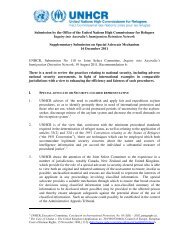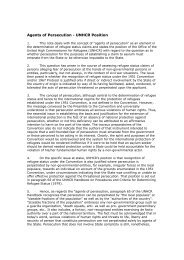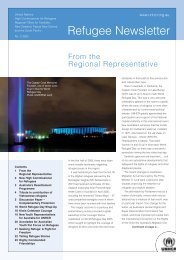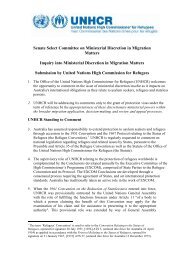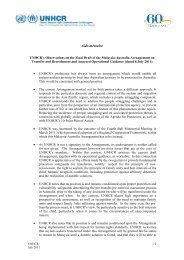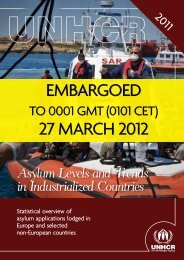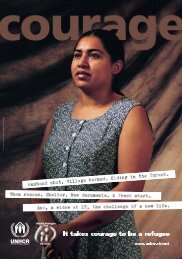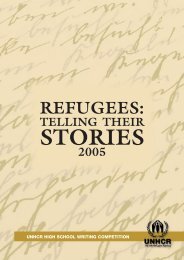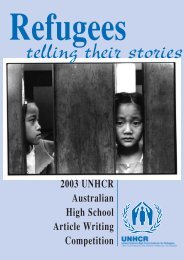download newsletter - unhcr
download newsletter - unhcr
download newsletter - unhcr
You also want an ePaper? Increase the reach of your titles
YUMPU automatically turns print PDFs into web optimized ePapers that Google loves.
The Principle of Effective Protection in the<br />
Australian Domestic Legal and Policy Context<br />
By the Department of<br />
Immigration, Multicultural<br />
and Indigenous Affairs<br />
THE REFUGEES Convention is<br />
founded on the principle that the<br />
protection it offers is protection of<br />
last resort. States should generally<br />
protect their own citizens. However,<br />
where that protection fails and a<br />
person with a well-founded fear of<br />
Convention persecution flees their<br />
home country, then there is an<br />
obligation on other States not to<br />
return (refoule) that person to the<br />
country they have fled. States did not<br />
include in the Refugees Convention<br />
an obligation to admit all asylum<br />
seekers who arrive at their border.<br />
Whilst States wanted to ensure that<br />
those who are forced to flee were not<br />
returned into the arms of their<br />
persecutors, they were not prepared<br />
to go so far as to agree that asylum<br />
seekers should be permitted to enter<br />
and reside in a country of their<br />
choice. A corollary of this is that the<br />
Refugees Convention does not<br />
preclude States from sending asylum<br />
seekers to countries where they do<br />
not have a well-founded fear of<br />
persecution.<br />
It is widely accepted among States<br />
party to the Refugees Convention and<br />
by the UNHCR, that denying a<br />
person access to asylum if he or she<br />
has found protection in another<br />
country is not problematic, provided<br />
the protection is both genuinely<br />
available and effective. 1 This is the<br />
international environment in which<br />
Australia’s law and policy on effective<br />
protection has developed.<br />
Australia’s migration policy<br />
generally, is underpinned by the<br />
principle that permanent and<br />
temporary international movement of<br />
people should occur, in so far as<br />
possible, in an orderly way, in<br />
accordance with the national laws of<br />
destination and origin countries and<br />
consistent with relevant international<br />
conventions. In the context of refugee<br />
movements, this means our<br />
preference is for a managed delivery<br />
of resettlement places to those<br />
identified in consultation with<br />
UNHCR as being in need of<br />
resettlement as a durable solution.<br />
As a signatory to the Refugees<br />
Convention, Australia takes its<br />
protection obligations seriously. It<br />
does not return people to countries in<br />
which they have a well-founded fear<br />
of refugee persecution. In some cases,<br />
however, a person in Australia may<br />
have effective protection elsewhere<br />
because of a right to enter and reside<br />
in a safe third country. In many such<br />
cases the individual has by-passed, or<br />
abandoned effective protection in a<br />
country of first asylum. This is known<br />
internationally, as ‘secondary<br />
movement’. As has been noted above,<br />
an asylum seeker who has reached a<br />
country where they can access<br />
effective protection does not have a<br />
“right”, under international law, to<br />
move on to a third country of choice.<br />
The issue of how to address the<br />
irregular, secondary movement of<br />
refugees and asylum seekers,<br />
particularly in an environment of<br />
people smuggling and trafficking, has<br />
been on the international agenda for<br />
a number of years. It is of concern to<br />
States that vast amounts of money<br />
and resources are expended on<br />
processing claims of asylum seekers<br />
who already had protection<br />
elsewhere. This has, in the past, led<br />
to a reduction in the resources<br />
expended on orderly resettlement<br />
programs and on resources made<br />
available to assist countries of first<br />
asylum in their refugee hosting<br />
responsibilities. 2<br />
Against this background, Australia<br />
has developed the principle of<br />
effective protection as one way of<br />
addressing secondary movements,<br />
while at the same time ensuring that<br />
Australia meets its international<br />
obligations, principally the key<br />
obligation of non-refoulement in<br />
Article 33 of the Convention. This<br />
approach has also allowed Australia<br />
to focus resources on those refugees<br />
in greatest need.<br />
Effective Protection in<br />
Australian statutory<br />
and common law<br />
UNDER Australian statutory and<br />
common law, Australia does not owe<br />
protection obligations to an asylum<br />
seeker who can access protection in a<br />
safe third country. A safe third<br />
country is one, other than Australia,<br />
in which the applicant would not be<br />
persecuted and from which the<br />
applicant would not be returned to<br />
the country of threatened persecution<br />
(ie not refouled). In some<br />
circumstances, therefore, a protection<br />
visa in Australia may be refused on<br />
the basis that the applicant has<br />
effective protection in a safe third<br />
country.<br />
Common law effective<br />
protection<br />
COMMON law effective protection<br />
has been developed through the<br />
Courts’ interpretation of the Refugees<br />
Convention in conjunction with<br />
Australia’s domestic legislation.<br />
Common law effective protection was<br />
first discussed in the 1997 decision of<br />
the Full Federal Court, MIMA v<br />
Thiyagarajah, in which it was held<br />
that a person who can be removed<br />
from Australia to another country,<br />
without putting Australia in breach of<br />
the non-refoulement obligation<br />
contained in the Refugees<br />
Convention, is not owed “protection<br />
obligations” for the purpose of the<br />
Migration Act (1958) and would,<br />
therefore, not be granted a protection<br />
visa.<br />
The ‘test’ for common law effective<br />
protection is whether “as a matter of<br />
practical reality and fact, the<br />
applicant is likely to be given<br />
effective protection by being<br />
permitted to enter and live in a third<br />
country where he will not be at any<br />
risk of being refouled to his original<br />
country...”. 3 This test requires the<br />
decision-maker to consider the<br />
circumstances of each applicant and<br />
the practical result of sending them<br />
to a third country. The right of entry,<br />
re-entry or residence does not have to<br />
be formal or legally enforceable, but<br />
rather there must be evidence that<br />
the person is able to access effective<br />
protection in the third country in a<br />
practical and factual sense.<br />
The Courts’ interpretation of<br />
effective protection is still evolving.<br />
An example of this is a recent Full<br />
Federal Court case, where the Court<br />
considered whether Jewish applicants<br />
from Russia had effective protection<br />
in Israel because of the ‘right of<br />
aliya’. 4 The Court held that effective<br />
protection could apply even though<br />
the applicants had never been to<br />
Israel and did not wish to go there.<br />
The Full Federal Court decision was<br />
appealed to the High Court which<br />
will not only consider effective<br />
protection in relation to aliya, but the<br />
broader issue of the effective<br />
protection doctrine, as developed by<br />
the Courts so far.<br />
Continued Page 5<br />
Discussion Paper<br />
4



